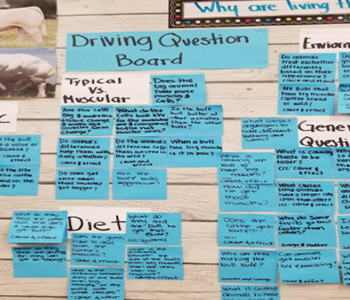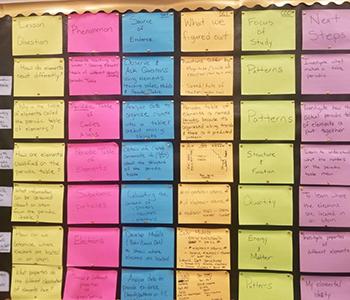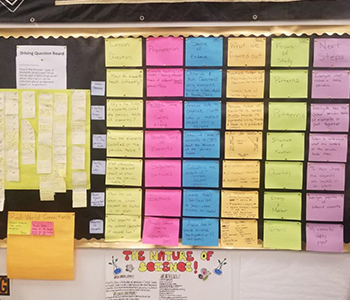Transforming the Classroom with OpenSciEd
By Susheela Valdez and Huda Ali Gubary
How often have you heard the following questions from your students: Why do I need to know this? Is this going to be on the test? Why does this matter? I, like you, have heard these questions repeated like a broken record over the years of being a middle school science teacher. While questioning was a goal of mine for my students, I was more interested in eliciting questions that would specifically be content related and, through their questioning, would engage them into taking accountability for driving their learning experience. Making students accountable for their own success isn't easy. As this became a reality in my class, it was very eye opening that I could be doing much more to provide opportunities that got my students to think in a broader sense. According to Vale, “Science begins by asking questions and then seeking answers. Young children understand this intuitively as they explore and try to make sense of their surroundings. . . . Encouraging questioning helps to bring the true spirit of science into our educational system, and the art of asking good questions constitutes an important skill to foster for practicing scientists.” (Vale, 2013)
I realized that at the end of each day I was tired from doing all the cognitive lifting while the students were leaving the classroom with more energy than they had walked in with. Something was definitely wrong with this picture. I was in desperate need to change the atmosphere in my classroom and turn the tables so that the bulk of the cognitive lift was being derived from the students and I could facilitate the learning. I began to question: “How could I make all students responsible for doing the thinking in this classroom?”
Can you imagine a classroom where all students think and learn at high levels and demonstrate clear depth of understanding? These classrooms do exist. My vision was to turn my classroom into one of these learning environments. I was in search of finding the right strategies that navigate these classroom experiences to show the level of thinking required of students to successfully engage with and make sense of a phenomenon or problem and provide the tools which help students see the connection and meaning of each lesson.
As an eager teacher looking for resources and avenues to make this transition in my classroom, I began learning and implementing the pedagogical and instructional shifts of the Next Generation Science Standards (NGSS), while being a part of the core leadership team through the CA NGSS Early Implementation Initiative. During this time I was given an opportunity to become a pilot field test teacher for OpenSciEd. OpenSciEd is a nonprofit organization that aims to improve science education through the development and implementation of high-quality, freely available science instructional materials. Each instructional unit is anchored in a phenomenon and has a coherent storyline throughout a learning sequence. Each learning sequence is rich with experiences that support the storyline and students and students making sense of the phenomenon. “To help teachers and students advance through the content of a unit, OpenSciEd takes advantage of routines—activities that play specific roles in advancing the storyline through the content with structures to help students achieve the objectives of those activities” (OpenSciEd.org). Embedded within the routines are instructional strategies that create an environment where the cognitive demand lies on the student. “At each step, students make progress on the classroom’s questions through science and engineering practices to figure out a piece of a science idea. Each piece they figure out adds to the developing explanation, model, or designed solution. Each step may also generate questions that lead to the next step in the storyline” (OpenSciEd.org)
The pedagogical shift from teaching discrete content topics which had limited clear connections to teaching phenomenon based units helps students explain the unit’s phenomena or solve the problems that they have identified and have provided the purpose for learning new science ideas. As they engage in the storyline, a coherent path is provided toward building science ideas piece by piece which are anchored in the students’ own questions.
It’s exciting to witness students explore the world around them like real scientists by observing, making connections, and asking questions. I give them the observable natural event and their naturally inquisitive nature provides the roadmap that will guide the unit’s storyline through the lessons taught. To support this process I have found the following instructional strategies invaluable; Driving Question Boards, Scientist Circles, and Learning Board Tracker (LBT) which was adapted from the Storyline and Progress Tracker.
The Driving Question Board (DQB) has transformed my science lessons. It has transferred ownership of learning from the teacher to the students. This means that students are motivated, engaged and self-directed. Students are able to monitor their own progress, reflect on their learning, and see the overall connection between the lessons they engage in the anchor phenomenon that they are trying to explain. As noted by Weizman, Shwartz & Fortus, there are four advantages to using the DQB as an instructional tool to help students make sense of phenomena:
- Helps students make connections between activities and anchoring phenomena / focus question
- Helps organize learning into a “road map” for students
- Scaffolds the students’ practice of asking questions
- Develops students’ ownership of the content and builds class community (Weizman, Shwartz & Fortus, 2008)
After observing, recording noticings/wonderings, and discussing the anchor phenomenon, students write their questions on post-its (1 question per note). The DQB holds all the students' questions and is their connection to the content and the buy-in to their learning. The DQB is revisited throughout the lessons. Student questions that have been answered are checked off and any new questions that arise are posted. Students also learn to classify questions and group them by similar categories. These groupings become the lessons that make up the phenomenon based unit.

Although the focus is on the NGSS Practice of Asking questions, which is one- dimensional, prompts can easily be added to highlight all three dimensions of the NGSS. While writing questions on post-it notes students are prompted to record what Crosscutting concept they are using as a lens to help answer their own questions. The DQB also facilitates rich science discourse based on common experiences, individual questions, and prior knowledge.
How do we facilitate productive science talk? The Scientist Circle strategy gave me the structure to support authentic student discussions. The purpose of the scientist circle is to have students share, clarify, and build on each other's ideas. It also gives the teacher a formative assessment opportunity. Discussions are an essential part of science. Not only does it support science learning, it supports both academic and non academic language development. Students need to make sense of what they are experiencing and one of the first ways they do this is by talking about what they observe, questions they have, and the connections they are able to make. Scientist circles lend themselves well to English Language Learners (ELLs) developing language and content knowledge. This instructional strategy encourages ELLs to make sense of their learning using everyday language while providing a bridge for the teacher to introduce academic language.
I use the scientists circle for both the DQB and the Learning Board Tracker. Students bring their notebooks and gather around so they are all facing each other for the discussion. In the DQB, the students get to share their questions, share their connections, and group questions based on similarity. During the Learning Board Tracker, the students build the unit’s story line by reflecting and recording their learning which emphasizes engaging in argumentation based on evidence. Students are encouraged to share their observations, interpret the evidence they obtained, and explain their findings to make sense of the phenomenon they are studying.

It is important to provide students with support to facilitate engagement in student-to-student discussions. I provide my students with sentence starters that they glue into their notebook and have ready at hand. As a teacher, it is also very important to be prepared to guide the conversation if necessary. To encourage in depth and robust productive science talk, I have to plan for the upcoming discussions. I do this by reflecting on the purpose of the scientists circle. I need to identify the intended outcomes of the discussion and what questions the students are trying to answer.
The purpose of this for you as a teacher is to think about expected student responses and to have probing questions on hand to guide the conversation among your students. A helpful resource that makes scientists' circles productive is “Goals for Productive Discussions and Nine Talk Moves,” which is adapted from the Science Talk in the Inquiry Project. These four goals provide an outline to achieve an in depth conversation among students:
- Goal One: Help Individual Students Share, Expand and Clarify Their Own Thinking
- Goal Two: Help Students Listen Carefully to One Another
- Goal Three: Help Students Deepen Their Reasoning
- Goal Four: Help Students Think With Others
One of the most powerful instructional strategies that I have implemented in my classroom is the Learning Board Tracker. This is the visual storyline that the unit follows. It engages students in processing data collected during investigations, answering the lesson questions with supporting evidence that helps them build an explanation of the phenomenon.
The Progress Tracker comes in at the end of the lesson. It is a 3-dimensional metacognition opportunity where students come together to discuss/reflect and provide evidence to show what they have learned. It becomes a record of their learning. The tracker has six categories that the students complete for each lesson. The categories are:
- The lesson question
- The investigative phenomenon for the lesson
- The science and engineering practice and the source of the collected evidence
- What was figured out - the answer to the lesson question which is based on a disciplinary core idea
- The focus of study - the crosscutting concept used
- The next steps - what we need to learn next to help us understand the anchor phenomenon

It is important to give students the opportunity to think, ask questions, and reflect on their own before coming to the scientist circle to complete the class Learning Board Tracker. This becomes a valuable opportunity for individual formative assessment. After the scientist circle and class learning board discussion, I can reassess students individually to see if they are able to use new info to build onto their thinking. These strategies engage students in where they feel invested in the learning and provide bridges between experiences and conceptual understanding.
Scientist Circle is the vehicle that gets you to the DQB and the LTB. It provides multiple opportunities for students to engage in argumentation and provide evidence, which all lead up to the end of the lesson, allowing you to develop the LTB. These strategies combined with the shift to phenomenon-based learning have transformed the classroom environment tremendously and equipped my students with two power tools: empowerment and accountability. The excuses have faded away as ownership has transferred from teacher to student. Now my students are exhausted leaving my classroom and I am ready to welcome the next group in.
References
Weizman, A., Shwartz, Y., & Fortus, D. (2008). The Driving Question Board. ProQuest Educational Journals, 75(8), 33–37.
Vale, R. D. (2013). The value of asking questions. Molecular Biology of the Cell, 24(6).
Susheela Valdez works for K-12 Alliance as a Regional Director with Science, Technology, Engineering, & Mathematics (STEM) at WestEd, Director and Statewide Collaborator with OpenSciEd and a member of CSTA.
Huda Ali Gubary works for Aspire’s secondary school, Vanguard College Preparatory Academy and teaches integrated science-8 and High School Chemistry, a teacher leader for the CA NGSS K-8 Early Implementation Initiative, curriculum pilot for OpenSciEd and a member of CSTA.






